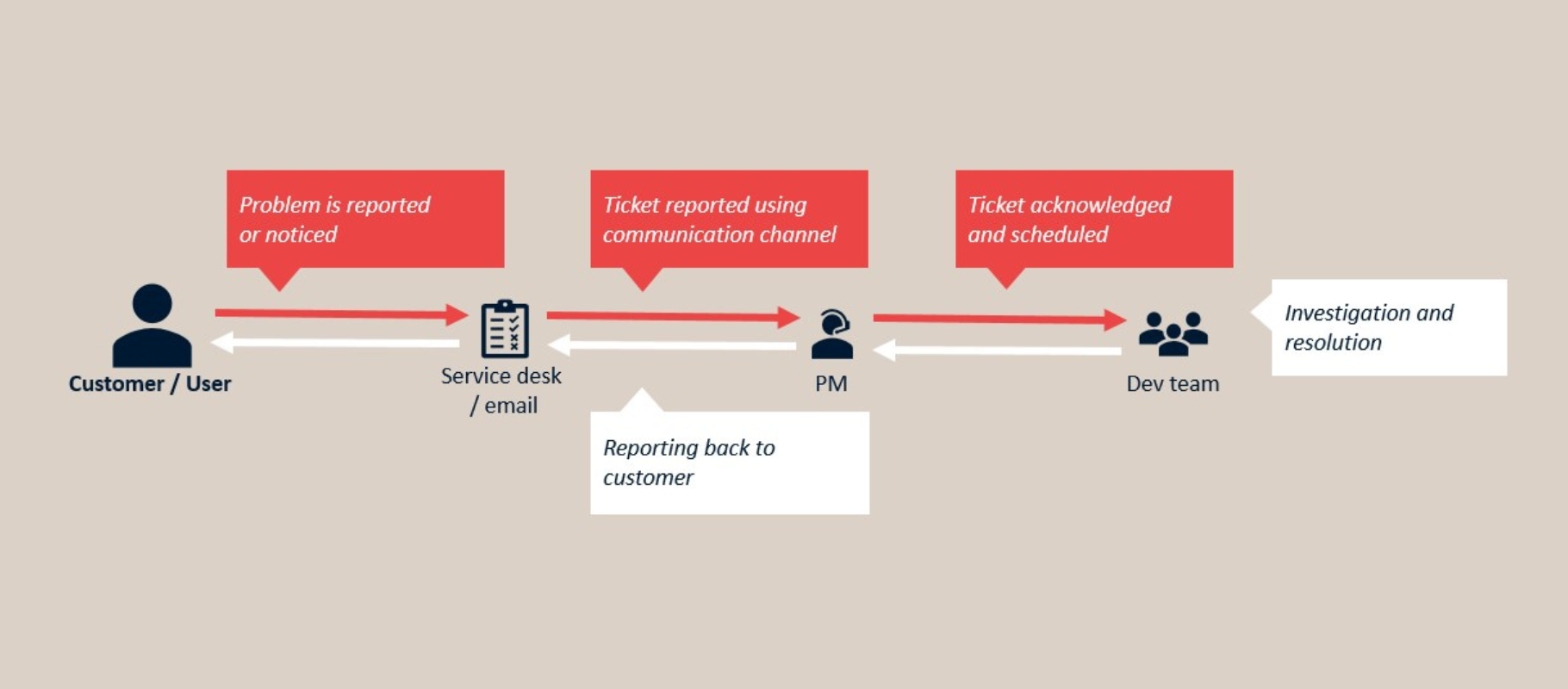Application monitoring - best practises
October 11, 2022 / 7 min read

Photo by Michał Jakubowski on Unsplash
Table of contents
What happens to your application after the release is as important as what happened during the development phase. Application monitoring is crucial to make sure the deployed solution delivers expected business results.
In this article we discuss:
What is application monitoring?
Application monitoring is a data-driven process of evaluating the way the application works in order to understand if it performs according to expectations. Developers track potential bugs, monitor performance, availability, efficiency and try to understand how the application is used by end-users.
By monitoring the logs of the application it is possible to quickly respond to any issues that can occur, constantly improve the speed and responsiveness of the app, as well as boost User Experience based on the data provided by actual users.
The importance of application monitoring
Post-release application monitoring has a great impact on the overall success of the investment in the new software solution. If this process is well thought-through, it:
- Ensures quality control
- Provides insights on performance and efficiency of the application
- Offers adherence to post-deployment budget strategies
- Increases visibility into how users use the application in real-life situations
- Fosters information sharing within the team
- Reduces risks related to bugs, downtime and other issues
What is more, the first few weeks and months after the release are usually crucial for the market reception of the application. Users usually give each tool just a one go, and the first impression often stays. Monitoring, maintenance and improvement processes of applications should focus on both end-user expectations as well as maximising stakeholders’ ROI by eliminating bugs, increasing quality, tweaking performance and boosting the speed of the software solution.
Different approaches to application monitoring
There are different approaches to monitoring the application, and there’s no ‘one size fits all’ strategy.
Lack of application monitoring
Some companies do not monitor the application at all – neither before, nor after the release. Naturally, this approach puts the whole investment in danger, as without proper monitoring, it is not possible to understand if you’re on track with budget, scope, deadlines, quality and performance of the solution.
Manual monitoring process
Other companies prefer to monitor the application manually, checking the performance and reporting conclusions ad hoc. Of course, it’s better to do it manually than to not monitor it at all, but this approach faces some serious limitations.
Automated application monitoring
Best-performing companies focus on automated application monitoring and leverage digital operation platforms and tools such as Pagerduty. By collecting relevent data insights in an automated way, it is possible to always stay on top of business-critial aspects of the application and make sure the monitoring is seamless and smooth.
The challenges of maintenance and monitoring of a web application
Software development is a challenging task itself – there's a variety of aspects the project team have to take into account when it comes to deadlines, budgets, quality and scope. Eventually, the development ends and application is realeased, available to end users and hopefully performing as expected.
Unfortunatelly, here’s where the lifecycle of plenty of projects ends. That’s a big mistake and directly hinders the business results of the application! There’s few reasons for that blur.
Lack of clear maintenance strategy
One of the most common reason is related to the lack of clear expectations. Often the monitoring and maintenance phase of the project is vague and undefined. If the IT partner who developed the solution does not come up with a sound plan for an effective process to monitor the application for potential issues, the stakeholders won’t do it either.
Budget constraints
Secondly, plenty of applications face significant budget limitations. At the post-deployment stage of the project lifecycle, usually the biggest chunk of the development and implementation budget is already allocated. Stakeholders expect that with the growing number of users, the application will start to deliver returns on investment according to their plans. Hence, it’s easy to simply ‘skip’ this phase and stop monitoring the application, since there’s no more budget to be spent on improvements anyway.
Despite this blur in strategy, responsibility and costs, the maintenance, evaluation and monitoring stages of the application are equally important as the development phase! Let's see how to do it right.
Monitoring web applications – examplary approach
Monitoring web applications comes down to detecting, diagnosing and resolving issues – at speed, effectively and accurately.
Every application has a set of specific, critical indicators that reflect it’s performance. There is plenty of monitoring tools to take into consideration when planning this process, that at the end of the day help your team increase load speed, perform regular hygiene checks, tweak performance and maintan the app at its optimum level.
The most important elements of web application monitoring project are:
- Backend and frontend logs gathering
- Performance monitoring
- Process for issue reporting
- Process for incident handling
Here is an example of what the process of a live application monitoring usually looks like. Usually the issues are spotted and reported by the users or the customer. Once IT support team is notified via a device desk system or direct email/phone call, they have to resolve the issue soonest possible. After receiving the ticket and assigning it to a selected responsible person, an investigation process starts. The point of contact on the customer side – often a Project Manager – is notified of the progress along the way. Users usually get notified by relevant communication platforms, as soon as the issue is resolved.
The diagram above explains a basic and usually default process of monitoring, that plenty of organisations implement. Unfortunately, this setup has plenty of disadvantages:
Reactiveness and marketing damage
The issues are reported by customers, or even worse – the users. When the support team resolves the issue it’s often too late and the damage to the image and market perception of the application is already done. Not to mention relying on customers and users to detect issues makes your support be only reactive in actions, not proactive and foreseeing.
Almost 90% of mobile users will stop using an application if they experience performance problems. [1]
Decentralisation
In this scenario the issues are not centralised in one repository. This results in potential chaos, as well as disproportionate reactions to specific tasks. Without centralisation, it’s challenging to implement an event and repetitive support process.
Manual and error-prone work
This setup results in a need to review each log from application manually by a member of the development team. Often, in order to stay on top of this potential mess, support engineers are forced to use several tools to gather the logs in different places and investigate them. This mundane work is often vulnerable to human error.
Plenty of times we observe that organisations adapt the ‘we’ll need it if it breaks’ kind of approach to application monitoring. They tend to oversee this aspect or even neglect it intentionally. As a result of this reactiveness, reporters of the incidents or issues need to wait significantly longer before the ticket is being handled accordingly. Lack of automatisation directly extends the time of response and takes the ball out of the support’s team court.
Another reason of such an disadvantageous monitoring setup is related to technical legacy related to inheriting external monitoring tools. That results in chaos and costs of subscriptions being out of control of the organisation, damaging the budget.
All in all, this manual process takes too long and is unnecessarily complicated. In a desired scenario, issues should be identified and dealt with upfront, before they significantly damage the user experience of the application. Customers are often reporting that using several different tools for an ongoing support operation (e.g. ordered new features vs support issues) is causing an inconvenience and stress.
That is why it is crucial to implement best practises of automatization and centralisation of application monitoring issues.
Application monitoring – it's all about the mindset
At NoA Ignite we understand that application monitoring and maintenance phase brings plenty of benefits to our customers and directly increases the chance of overall business success of each project. That is why our Customer Success team consists of experts who always make sure we don’t oversee any important aspects of this stage.
Our first goal is usually preparing a plan with the customer that covers building a support team. This team often consists of a part of the development team, a project manager and a customer success manager. Sometimes the stakeholders on the customer side also are involved, according to their availability. This setup ensures everyone has their own responsibilities and that all crucial aspects of the process are covered.
It is important not only to tackle the technical challenges our working application will face, but also to stay ahead of the game and try to foresee what sort of expectations end-users might have, and act accordingly in advance. An advanced and ongoing insight into the application usage and performance delivers valuable input that generates ideas for improvement. Data-based solutions are usually the most rich in tangible business insights. That is why we invest time to build a deep understanding of the business of the customer, so that we can craft a valuable and relevant roadmap for development.
But to hit each milestone of this roadmap, the day-by-day operation of the application must be spotless. Development of new features will always come after making sure the basic features and general reliability of application is not at risk. Hence it’s essential to foster the mindset that emphasises the importance of proper monitoring.
Best practices of application monitoring
Although the aspects of monitoring the application after its deployment may sound vague and confusing, there is a list of best practices to follow that will help to stay on top of the situation:
- Build a team that is in it together and that has enough relevant expertise to cover the monitoring of the entire solution
- Use the right tools and automate whenever possible to increase efficiency and improve response time
- Foster the right mindset within the team not to oversee anything important
- Crate the process and trust it
The above is just scratching the surface of a very important subject related to the overall business success of your application. As much as DevOps is all about building a culture, application monitoring bases on fostering a mindset of automation and responsibility.
If you want to learn more about how to tackle this challenge, the experts at NoA Ignite are here to talk. Reach out to dive deeper into the subject of application monitoring!
(1) https://docs.broadcom.com/doc/the-definitive-guide-to-application-performance-monitoring https://revdebug.com/blog/what-is-application-performance-monitoring/
Author

Mariusz Rajkowski
Project Manager
Mariusz is a Project Manager with several years of experience in project management in different areas of technology and business, as well as postgraduate studies in Project Management with a specialty in IT Project Management. Throughout his career, Mariusz has held the roles of advisor, platform specialist, and team leader, always offering professional support on both the consultative and project management levels.
Related articles
![A well-crafted prompt doesn’t just work once. It works across teams, channels, and campaigns. It can be tweaked for new use cases and refined based on what performs best.]()
June 27, 2025 / 4 min read
Prompts are marketing assets: how to reuse, and scale them
Prompts aren’t throwaway lines. They’re repeatable, scalable assets that can streamline your marketing your team’s output. Learn how to build a prompt library that delivers.
![Woman using a wheelchair in the office settings]()
June 17, 2025 / 5 min read
What is accessibility and why it matters?
Accessibility ensures everyone — including those with disabilities or limitations — can read, navigate, and engage with your content equally.



